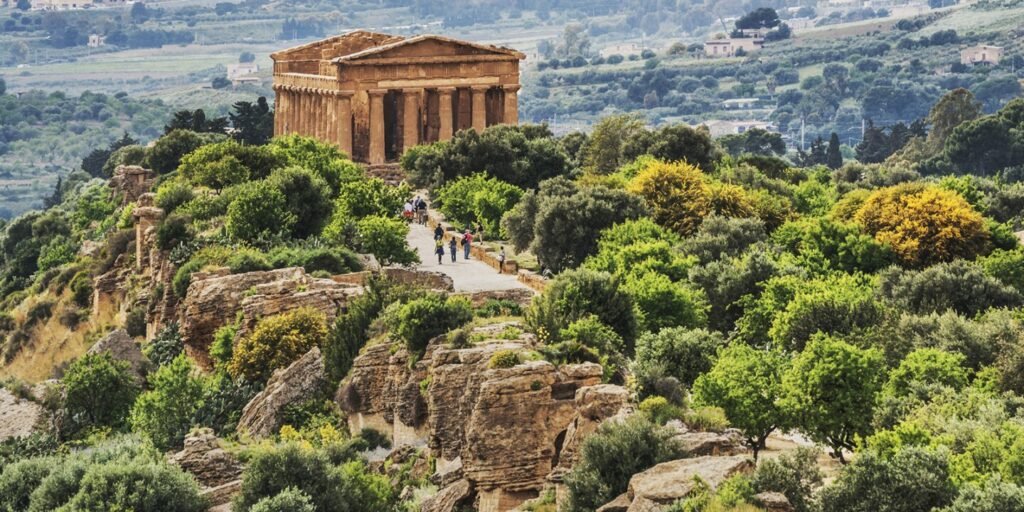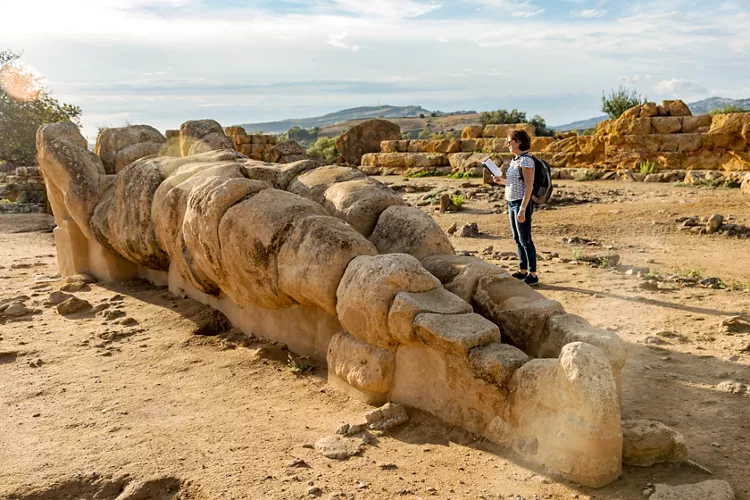On the southern coast of Sicily lies the famous city of Argigento. The greatest attraction of Agrigento is undoubtedly Valle dei Templi, or the Valley of the Temples, whose history dates back to the times of the Greek colony of Akragas. The Valley of the Temples (Valle dei Templi) covers a large area in the southern part of the ancient city. The name is misleading as it is actually a ridge rather than a valley. At least that’s what it looks like from the sea. It is also worth seeing the Turkish Steps, beaches, fascinating nature reserves and, of course, monuments! Also come to the annual Almond Blossom Festival.

It is known as the site of the ancient Greek city of Akragas, one of the main cities in Magna Graecia during the golden age in ancient Greece. The city was founded around 582-580 BC. by Greek colonists from Gela.
Valley of the Temples



The Valley of the Temples, owned by Valle dei Templi, is an archaeological and landscape park in Agrigento which contains the remains of the buildings of the ancient city of Akragas. The Valley of the Temples was included on the UNESCO World Heritage List in 1997 as the Archaeological Zone of Agrigento. It covers an area of approximately 1,800 hectares.
The Valley of the Temples (Valle dei templi) is located below the city. The complex consists of numerous temples with varying degrees of preservation, including: the Temple of Hercules (Tempio di Ercole), the best preserved Temple of Concord (Tempio della Concordia) which owes its condition to its transformation into a Christian temple, the Temple of Juno (Tempio di Giunone), the Temple of Jupiter (Tempio di Giove). It is the largest complex of Greek buildings that we can visit outside Greece.
Temple of Concordia

The Temple of Concordia, built around the 5th century, is located along the Via Sacra and is the best preserved. In the 6th century, it was transformed into a sacred building. The name Concordia comes from a Latin inscription found in the vicinity of the temple.
Temple of Heracles

The Temple of Heracles (Hercules) is the oldest. It housed a bronze statue of the hero Hercules himself, who was particularly venerated by the Akragantines. The temple, destroyed by war and probably by an earthquake, today retains only eight columns of the original 38.
Archaeological Museum “Pietro Griffo”


The Regional Archaeological Museum “Pietro Griffo” in Agrigento is certainly one of the most important and visited archaeological museums in Sicily. The building was designed by Franco Minissi and constructed in the 1960’s on the site of the ancient agora where the villa of Ciantro Panitteri once stood. It shows a perfect blending of old restored remains (Cloister of the Convent of St Nicholas) and new structures. The archaeological museum displays over 5688 artefacts that, arranged both in chronological and topographical order, illustrate the history of the Agrigentan territory from prehistoric times to the end of the Greek- Roman period. The collections partly come from the Civic Museum (items found at the beginning of 20th century) and from private collections or were ceded by other museums.
Kolymbethra Garden


Kolymbethra Garden is a special area inside the Valley of the Temples in Agrigento, where history and nature meet. Its origin is a water source for the Greek city of Akragas, founded in the 6th century b.C.: a big pool “whose perimeter was 7 stadui” (this is what Kolymbethra means), that worked as an junction point of underground galleries.
Then it was turned into a fishpond and became a wonderful garden full of Mediterranean plants thanks to the constant flowing of water. As the time went by it became property of the Catholic Church that introduced the citrus trees, giving such a fascinating look that this “garden of delights” became a step of the European Grand Tour in the 19th century. When the old farmers left, the garden was abandoned and the Regional Government entrusted it to FAI in 1999, when several interventions started.
Agrigento Old Town


Discover all of the corners of this city and get lost in the labyrinthine streets until you stumble upon significant monuments. Testimony of Agrigento’s multicultural history are the Arabe maze streets and courtyards, Norman palaces and churches and the baroque architecture of Spanish derivation. Via Atena is the long main street that the locals use for their daily stroll – a passeggiata for them. Allow yourself to join in and visit the many interesting churches and palaces that are mostly along this boulevard or nearby.
The main sites to look out for: San Pietro’s church, San Francesco’s church, chapel of St. Anthony, San Lorenzo’s church (or Purgatory), Santa Rosalia’s church, Purgatory Hypogeum, St. Joseph’s church, Collegio dei Padri Filippini, San Domenico’s church, the Town Hall (Municipio in Italian) with the Pirandello Theatre inside, St. Mary of the Greeks church, Santo Spirito Monastery, and much, much more. But don’t stop till you reach the very top of Agrigento where you will find the main site of the city centre, the Cathedral of San Geraldo that was erected in 1301 for the first bishop of the city.
Turkish Steps


Turkish Steps – white limestone cliff on the sea shore near the town of Porto Empedocle, near Agrigento, Sicily. The name refers to Turkish pirates who took refuge in this place from storms. La Scala dei Turchi, or the Turkish Steps, is a sloping staircase of white rock leading to the ocean near Agrigento. Surrounded by two beautiful beaches, the terraced cliff is one of the most remarkable sights in Sicily .
Torre Salsa Nature Reserve


There are several beaches in the Torre Salsa nature reserve, as well smaller coves.
Spiaggia Libera: This is the main beach and the one that is most accessible from the car park.
Spiaggia Naturista: This is a nudist beach within the reserve, east of the main beach. To access it, you’ll need to follow the coastline.
Costone bianco: A smaller version of Scala dei Turchi that you can still access.
If you’re planning on spending several hours here it is best to come prepared with food and water. Additionally, there is no shade along the beach, so for stays of more than a couple of hours we’d highly recommend also bringing a parasol for a bit of respite from the sun.
The very particular landscape of Torre Salsa Reserve – and its protected state – means that this area of of South West Sicily is home to a wide variety of flora and fauna.Twitchers will be delighted to discover that nearly 30 species of birds nest in the area, including several birds of prey (peregrine falcons, buzzards, kestrels, owls and horned owls), the increasingly rare Cannaiola and several of those common to low cliffs that feed on the abundant fish population. With regards to mammals, the two most interesting are the porcupines – which are unfortunately still being poached by local hunters – and the small caretta caretta turtles which come to lay eggs along the beach.
Punta Bianca Nature Reserve

The Punta Bianca nature reserve is an electrifying experience for trekking enthusiasts, eager to venture along the paths of a place that is still not very common on the main tourist itineraries and is therefore wild and unspoiled. From these places you can enjoy a dream view of the Mediterranean from an authentic natural terrace overlooking the sea, enriched by the typical Mediterranean scrub and by a peculiar avian fauna, which makes the site indispensable for birdwatchers.
Almond Blossom Festival


Almond Blossom Festival (Italian: Sagra del mandrolo in fiore) – a folk festival welcoming spring, initiated in the 1930s in Agrigento, Sicily. The first celebrations took place in 1934 on the initiative of Count Alfonso Gaetani. Its 74th edition took place in 2019. Traditionally, the holiday is celebrated during the flowering time of the common almond tree, usually from the first to the second Sunday of February, sometimes at other times, also in March.
